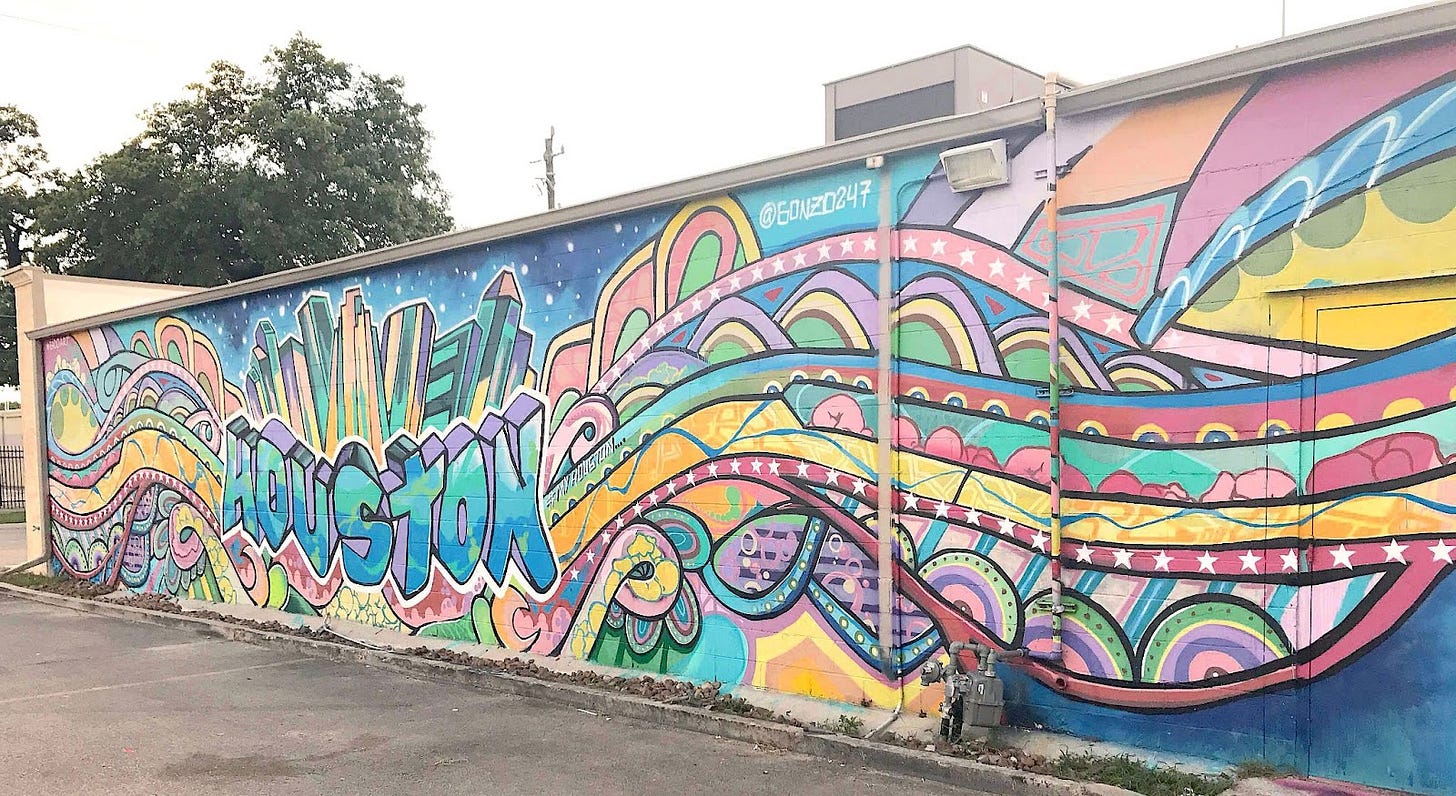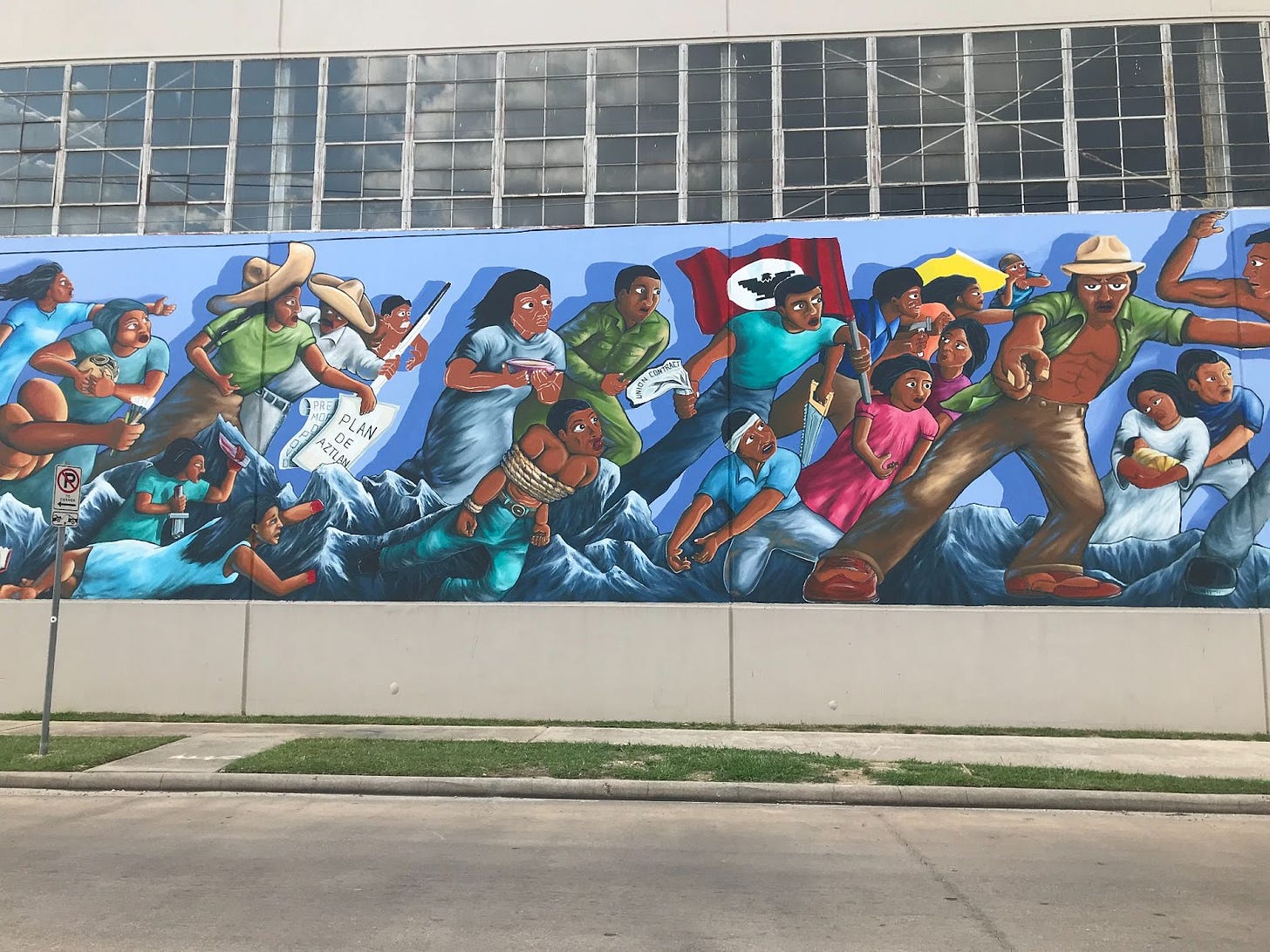Latino Artist Gonzo247 Transforms Houston’s Walls
Houston’s skyline has changed dramatically in the last two decades, and Mario E. Figueroa, aka Gonzo247, has made sure that Latino art has kept up with the exciting and transformative urban landscape. As Houston, one of America’s largest cities, added more skyscrapers and new hospital buildings, Gonzo, the founder of the downtown Graffiti Park and co-founder of the area’s Wall of Fame, made sure that public art resonated with Latino and Black Houstonians.
“Houston” mural by Gonzo247 at 2011 Leeland St. Photo by Ricardo Romo, 2019.
Gonzo grew up in the East End of Houston,
a blue-collar barrio where industrial factories, warehouses, and shipping docks dominate the landscape. In his bio Gonzo explained that as a youth in the late 1970s exposure to Leo Tanguma’s monumental mural in the East End, “The Rebirth of Our Nationality” [1973], and later the visual language of Hip Hop, made a dramatic impact on his interest in art.
The Tanguma mural on Canal Street is located in the heart of Houston’s East End barrio. In the early 1970s when Tanguma painted his murals, Latinos in Houston represented a smaller and somewhat invisible minority. Most lived in isolated barrios like the East End where the majority of residents made less than minimum wage and experienced educational opportunities that ended with high school.
Gonzo’s restoration of Leo Tanguma’s mural. Photo by Ricardo Romo, 2019.
According to artist Leo Tanguma’s mural images and his own verbal interpretation of his work, young people’s experiences of growing up in the East End barrio differed from those of the majority of Houston’s youth. Latino youth worried daily about “police brutality, man’s assault on the environment, youth violence, and the struggles of women, the elderly, and the working class.”
During his teenage years, Gonzo, like many of his peers, was attracted to Hip-Hop music, skateboarding, and informal weekend recreational sports. Gonzo also became an early advocate of graffiti art. He explained to the Rice University campus newspaper, The Rice Thresher, “I think when you’re a Brown kid from the east side of town, seeing classical architecture or elaborate Renaissance oil paintings, I couldn’t connect with the content,” nor the materials and the mediums of classical art. Gonzo discovered at age 17 the excitement of using spray paint for art. He added: “There was no right or wrong way to do it.” His graffiti art began as a visual language of Hip-Hop with an emphasis on stylized rhythmic movement.
Tanguma’s mural work also inspired Gonzo. As a teenager, Gonzo painted his first mural in 1990. In 1992, Gonzo247 partnered with fellow graffiti artist Merge360 to establish the “Wall of Fame,” which visitors can view today on Palmer and McKinney Streets. This area became the first legal spot for artists to engage in graffiti. The following year Gonzo founded Aerosol Warfare, a video magazine, and began his work as the producer of the Houston Urban Experience Mural Festival [HUE]. The HUE project is especially significant in that it invites muralists from around the world to participate in painting murals in Houston’s Graffiti Park.
Gonzo247 leading a tour of Graffiti Park. Photo by Ricardo Romo, 2019.
Gonzo moves about the city with ease and often boasts of Houston’s “small town” feel to the many out-of-town visitors who come to see his murals. Although Houston is the largest city in Texas and the fourth-largest city in the U.S., the city presents more opportunities than challenges for Gonzo. His murals are located throughout the urban area. Over the past two decades, Gonzo has painted more than 50 murals in Houston.
In 2020 the city’s metropolitan population surpassed seven million, with the growth of Latino, Black, and Asian populations especially significant. The Google search that gave me that statistic actually had Gonzo’s “Houston” image on its website! The image came from a mural at 2011 Leeland St in downtown Houston [77003]. Houston is now home to the third-largest Latino population in the United States.
Bob Phillips, writing for Texas Monthly, commented that for most of Gonzo’s life the artist “made art that wasn’t really considered art at all.” That changed in 2017 when the city commissioned Gonzo to “grace the walls of the newly expanded George R. Brown Convention Center.” Phillips noted that Gonzo’s style of bold brushstrokes represented a sure sign that GONZO247, and his art commonly referred to as graffiti, “has been pulled out of the back alleys and into the mainstream.”
It is fitting that Gonzo initiated one of the largest mural conservation projects of the state in 2018 when he restored with fresh paint the Tanguma mural that he had admired as a young boy. Located on the old Continental Can Company wall, the Tanguma mural restoration represents one of Gonzo’s most ambitious projects. The bright renewal of Tanguma’s 240 foot-long mural took months to complete. Several generous grants made the work possible. Tanguma’s mural represents one of the first large Latino murals in the Southwest and remains the largest in Texas.
In 2021, Rice University commissioned Gonzo to work with students, staff, and community members to “spearhead a new campus mural.” The campus newspaper urged the campus community to sign up to contribute to the painting of the new mural--no experience required. The mural, now completed, represents one of the largest Latino public art projects in a university setting.
Rice University mural. Lead artist Gonzo247. Photo courtesy of Gonzo247 and Carolyn Casey Figueroa.
Gonzo has an impressive following among Houston’s Latino community, which now numbers more than two million in the metro region and accounts for 40.9 percent of the city’s population. The Latino poverty level of 20.06% remains one of the many factors that explain the income gap between Latino and White residents. Gonzo understands that most Latinos will never visit an art museum, and he wants public art to make up for that loss.
Houston has shown a great acceptance of public murals and street art which has made Gonzo an international art figure. Gonzo knows that although it has taken more than 20 years to win local acceptance, the future looks bright for the hundreds of artists like him-- self-taught artists who were inspired by public art and Hip Hop music.
Gonzo does not limit his art to Houston’s public walls. In an art essay, “Houston’s Graffiti Culture,” Nimra Haroon wrote that Gonzo “has worked his graffiti magic around house designs, automobiles, skateboards, helmets, fashion apparel, interior design products, and more.” While Gonzo’s future as an art innovator is now secure, he remains fully committed to his first love--public art.






